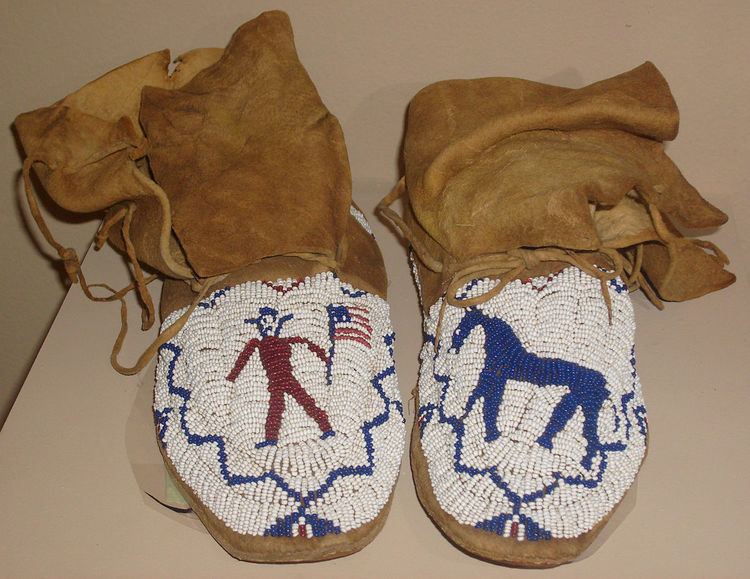 | ||
The Shoshone or Shoshoni (/ʃoʊˈʃoʊniː/ or /ʃəˈʃoʊniː/) are a Native American tribe with four large cultural/linguistic divisions:
Contents
- Name origin
- Language
- History
- Historical population
- Bands
- Reservations and Indian colonies
- Notable Shoshone people
- References
They traditionally speak the Shoshoni language, part of the Numic languages branch of the large Uto-Aztecan language family. The Shoshone were sometimes called the Snake Indians by neighboring tribes and early American explorers.
Their peoples have become members of federally recognized tribes throughout their traditional areas of settlement, often colocated with the Paiute and Washoe peoples of the Great Basin.
Name origin
The name "Shoshone" comes from Sosoni, a Shoshone word for high-growing grasses. Some neighboring tribes call the Shoshone "Grass House People," based on their traditional homes made from soshoni'. Shoshones call themselves Newe, meaning "People."
Meriwether Lewis recorded the tribe as the "Sosonees or snake Indians" in 1805.
Language
The Shoshoni language is spoken by approximately 1,000 people today. It belongs to the Central Numic branch of the Uto-Aztecan language family. Speakers are scattered from central Nevada to central Wyoming.
The largest numbers of Shoshoni speakers (including children) live on the federally recognized Duck Valley Indian Reservation, located on the border of Nevada and Idaho; and Goshute Reservation in Utah. Idaho State University also offers Shoshoni-language classes.
History
The Shoshone are a Native American tribe, who originated in the western Great Basin and spread north and east into present-day Idaho and Wyoming. By 1500, some Eastern Shoshone had crossed the Rocky Mountains into the Great Plains. After 1750, warfare and pressure from the Blackfoot, Crow, Lakota, Cheyenne, and Arapaho pushed Eastern Shoshone south and westward. Some of them moved as far south as Texas, emerging as the Comanche by 1700.
As more European-American settlers migrated west, tensions rose with the indigenous people over competition for territory and resources. Wars occurred throughout the second half of the 19th century. The Northern Shoshone, led by Chief Pocatello, fought during the 1860s with settlers in Idaho (where the city Pocatello was named for him). As more settlers encroached on Shoshone hunting territory, the natives raided farms and ranches for food, and attacked immigrants.
The warfare resulted in the Bear River Massacre (1863), when US forces attacked and killed an estimated 410 Northwestern Shoshone, who were at their winter encampment. A large number of the dead were civilians, including women and children, deliberately killed by the soldiers. This was the highest number of deaths which the Shoshone suffered at the hands of United States forces.
Allied with the Bannock, to whom they were related, the Shoshone fought against the United States in the Snake War from 1864 to 1868. They fought US forces together in 1878 in the Bannock War. In 1876, by contrast, the Shoshone fought alongside the U.S. Army in the Battle of the Rosebud against their traditional enemies, the Lakota and Cheyenne.
In 1879 a band of approximately 300 Eastern Shoshone (known as "Sheepeaters") became involved in the Sheepeater Indian War. It was the last Indian war fought in the Pacific Northwest region of the present-day United States.
In 1911 a small group of Bannock under a leader named Mike Daggett, also known as "Shoshone Mike," killed four ranchers in Washoe County, Nevada. The settlers formed a posse and went out after the Native Americans. They caught up with the Bannock band on February 26, 1911 and killed eight. They lost one man of the posse, Ed Hogle. The posse captured three children and a woman.
A rancher donated the partial remains of three adult males, two adult females, two adolescent males, and three children (believed to be Shoshone Mike and his family, according to contemporary accounts) to the Smithsonian Institution in Washington, DC for study. In 1994, the institution repatriated the remains to the Fort Hall Idaho Shoshone-Bannock Tribe.
In 2008 the Northwestern Shoshone acquired the site of the Bear River Massacre and some surrounding land. They wanted to protect the holy land and to build a memorial to the massacre, the largest their nation had suffered. "In partnership with the American West Heritage Center and state leaders in Idaho and Utah, the tribe has developed public/private partnerships to advance tribal cultural preservation and economic development goals." They have become a leader in developing tribal renewable energy.
Historical population
In 1845 the estimated population of Northern and Western Shoshone was 4,500, much reduced after they had suffered infectious disease epidemics and warfare. The completion of the First Transcontinental Railroad in 1869 was followed by European-American immigrants arriving in unprecedented numbers in the territory.
In 1937 the Bureau of Indian Affairs counted 3,650 Northern Shoshone and 1,201 Western Shoshone. As of the 2000 census, some 12,000 persons identified as Shoshone.
Bands
Shoshone people are divided into traditional bands based both on their homelands and primary food sources. These include:
